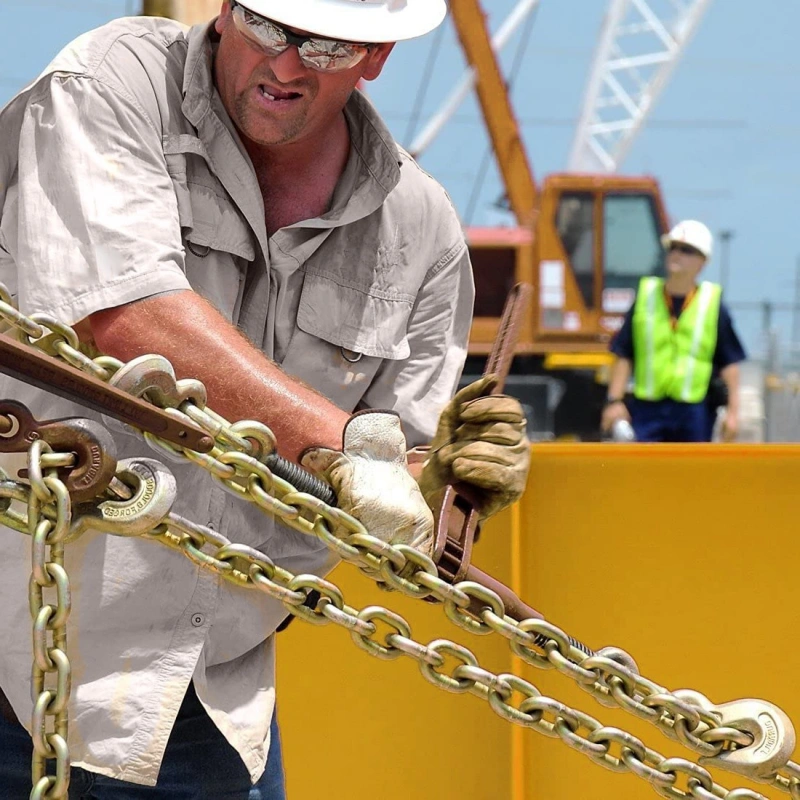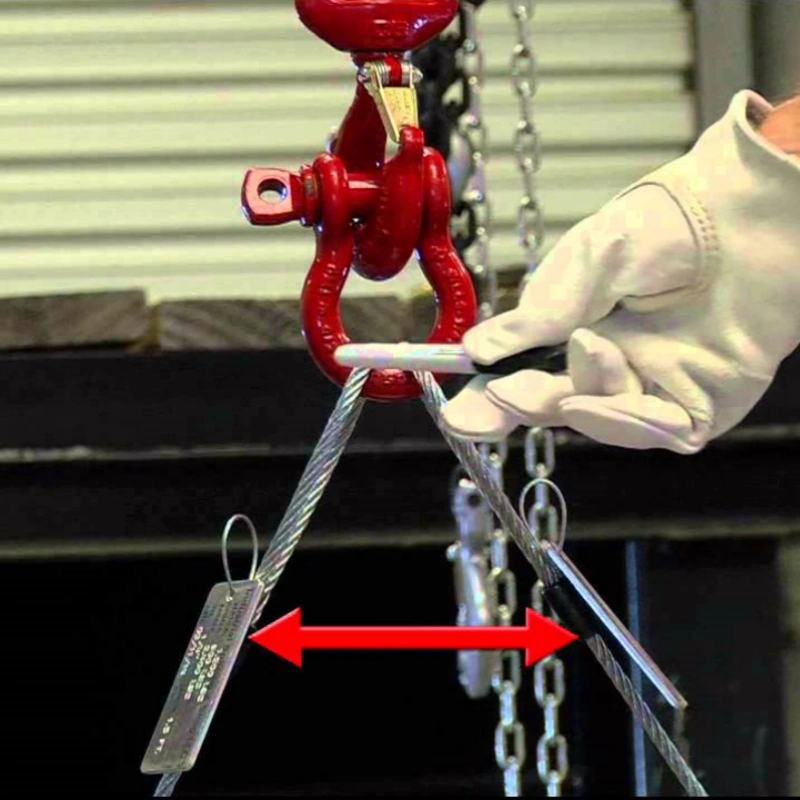You encounter turnbuckles in many rigging systems when you need to create precise tension. A turnbuckle adjusts the length and tension of cables, wires, or ropes, making it essential for safety in construction, marine, and industrial settings.
Over 60% of large-scale projects use turnbuckles for stabilizing cable systems. Powerful Machinery supplies certified turnbuckles in stainless steel and galvanized finishes, helping you match the right type and material to your installation. The table below shows common types and applications:
| Type of Turnbuckle | Description | Common Applications |
|---|---|---|
| Jaw and Jaw | Heavy-duty and secure | Industrial or structural projects |
| Eye and Jaw | Strength and versatility | Marine and fencing applications |
| Eye and Eye | Permanent loop ends | Wire rope tensioning systems |
| Hook and Hook | Quick connect/release | Temporary setups |
| Hook and Eye | Flexible, moderate load | Fencing or temporary rigging |
Choosing the right turnbuckle ensures safety and reliable performance in any environment. If you wonder what turnbuckles are used for, you see them in everything from shipyards to shade sail installations.
Key Takeaways
- Turnbuckles adjust the tension of cables, ropes, or wires, making them essential for safety in construction and marine projects.
- Choose the right type of turnbuckle based on your needs: jaw for secure connections, eye for loops, and hook for quick attachments.
- Always check the direction of the threads before adjusting a turnbuckle to avoid damage and ensure safe operation.
- Regularly inspect turnbuckles for wear and corrosion to maintain safety and performance in your rigging systems.
- Use locking mechanisms like lock nuts or safety wires to prevent turnbuckles from loosening over time.
What is a Turnbuckle?
Definition
A turnbuckle is a simple but powerful device you use to adjust the tension or length of cables, ropes, or rods in a rigging system. According to engineering standards like ASME B30.26, a turnbuckle consists of three main parts: a body, a right-hand threaded end fitting, and a left-hand threaded end fitting.
You can find turnbuckles in many industries because they let you make precise adjustments to keep structures stable and secure. When you need to tighten or loosen a cable, a turnbuckle gives you control and flexibility.
How Does a Turnbuckle Work?
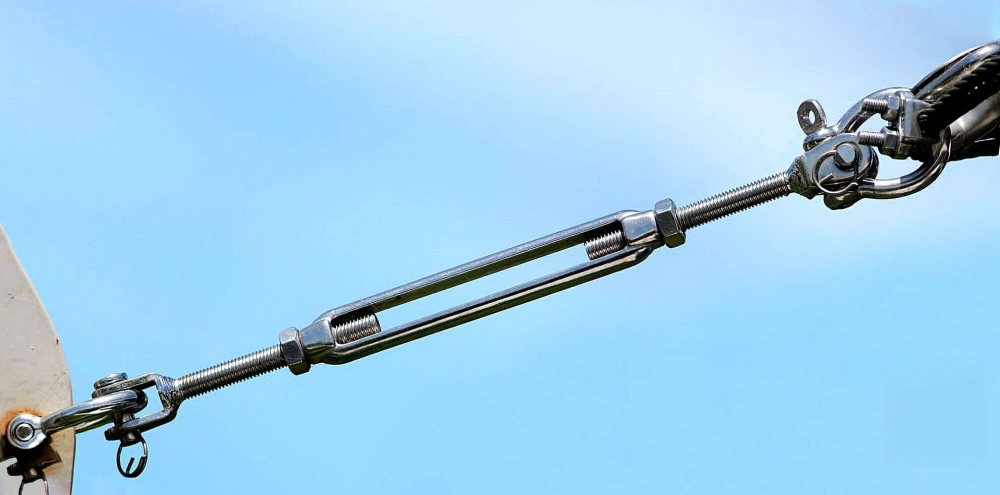
You might wonder, how do turnbuckles work? The answer lies in their clever design. A turnbuckle has a barrel or body with internal threads at both ends. One end uses a right-hand thread, and the other uses a left-hand thread.
When you rotate the body, both ends move either closer together or farther apart at the same time. This action lets you increase or decrease the tension in the connected cables or rods without disconnecting them.
| Action | Description |
|---|---|
| Design | A turnbuckle consists of a barrel with internal threads at both ends. |
| Threading | One end has a right-hand thread and the other a left-hand thread. |
| Function | Rotating the barrel adjusts the length and tension of the connected rods. |
| Adjustment Mechanism | Each full turn of the barrel shortens the device by 2*p, where p is the pitch of the threads. |
You often see turnbuckles in places where you need to adjust tension quickly and safely. For example, you use them in aircraft to adjust the tension on structural wires that brace the wings.
You also find them in flexible cables for flight control systems. In construction, marine, and even residential projects, turnbuckles help you keep cables tight and secure.
Tip: Always check the direction of the threads before you start adjusting a turnbuckle. This helps you avoid stripping the threads or damaging the fittings.
What Does a Turnbuckle Look Like?
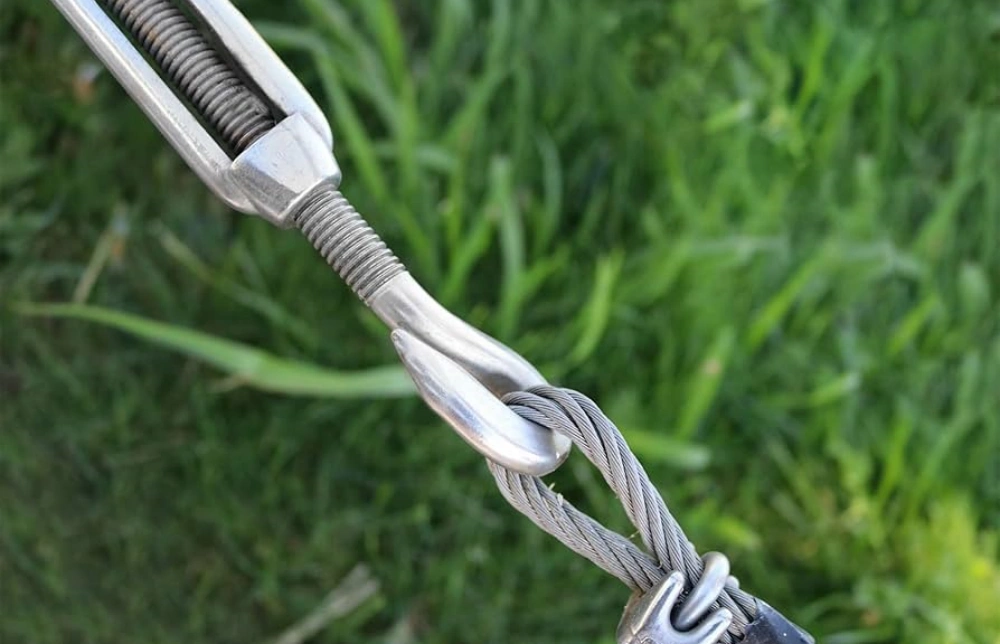
Turnbuckles have a unique look that makes them easy to recognize. You see a long, metal body with threads on both ends. The body can be open, where you see the threads running through the frame, or closed, where the threads are hidden inside a pipe-like casing.
The end fittings attach to the cables or rods and come in different shapes, such as jaws, eyes, or hooks, depending on your application.
| Feature | Description |
|---|---|
| Body | A long, threaded body with different internal threading on each side. |
| End Fittings | Two threaded end fittings that can vary based on application (e.g., jaw, eye). |
| Body Type | Open body (threads visible) or closed body (threads encased in a frame). |
You can spot open body turnbuckles by their visible threads, which make it easy to see how much adjustment you have left. Closed body turnbuckles have a slimmer profile and protect the threads from dirt and damage. Both types serve the same purpose, but you choose one based on your environment and needs.
- Open body turnbuckles show the threads through the frame.
- Closed body turnbuckles hide the threads for a cleaner look and extra protection.
When you select a turnbuckle, pay attention to its size, material, and end fittings. These features help you match the right turnbuckle to your rigging system and ensure safe, reliable performance.
Turnbuckle Structure
Understanding the parts and types of turnbuckles helps you choose the right solution for your rigging needs. Each component plays a key role in how turnbuckles adjust tension and maintain safety.
Body Types
Turnbuckles come in several body types, each designed for specific uses. The table below shows common turnbuckle types and their advantages:
| Turnbuckle Type | Advantages |
|---|---|
| Open Body Turnbuckles | Easy manual adjustments, ideal for frequent tension changes in outdoor rigging and temporary structures. |
| Closed Body Turnbuckles | Streamlined design reduces snagging, secure fastening for permanent installations, and cleaner aesthetics. |
| Adjustable Turnbuckles | Quick adjustments, suitable for scenarios requiring frequent tension alterations, are reliable in various settings. |
| Mechanical Turnbuckles | Precise adjustments without manual turning, useful in high-tension applications, are found in specialized fields. |
| Heavy-Duty Turnbuckles | Made from robust materials for strength and durability, ideal for harsh conditions and heavy loads. |
You often see open body turnbuckles in outdoor projects where you need to check the threads. Closed body types work well in permanent or architectural settings. Powerful Machinery engineers each body type for strength and reliability, using high-quality materials to ensure long-lasting performance.
End Fittings
You can select from different types of end fittings to match your application. The most common turnbuckle types include:
- Jaw and Jaw Turnbuckle
- Jaw and Eye Turnbuckle
- Eye and Eye Turnbuckle
- Hook and Eye Turnbuckle
- Hook and Hook Turnbuckle
Each fitting serves a purpose. Jaw ends provide secure connections for construction and rigging. Eye ends create permanent loops for fencing or bridges. Hook ends allow quick attachment and release, making them useful for temporary setups.
Powerful Machinery offers a wide range of end fittings to suit your project, whether you work in construction, agriculture, or marine environments.
Locking Mechanisms
Turnbuckles can loosen over time, especially in areas with vibration. To prevent accidental loosening, you should use locking mechanisms such as lock nuts, jam nuts, or safety wires.
These features keep the tension secure and help maintain safety in your rigging system. Powerful Machinery includes reliable locking options in its designs, so you can trust your installation to stay tight.
Tip: Always check that your locking mechanism is in place before you apply load to your turnbuckle.
Take-Up Length
Take-up length refers to how much you can adjust the turnbuckle to increase or decrease tension. This range depends on the size and type of turnbuckle you choose. A longer take-up length gives you more flexibility when tightening or loosening cables.
When you select a turnbuckle from Powerful Machinery, you can find detailed specifications for take-up length, helping you match the right product to your needs.
By understanding the parts and types of turnbuckles, you can make informed decisions for your rigging projects. Powerful Machinery’s engineering ensures every component meets strict quality standards, giving you confidence in every installation.
Types of Turnbuckles
When you explore turnbuckles, you find a wide range of types and end fittings. Each type serves a specific purpose in rigging and tensioning systems. Powerful Machinery offers a complete selection, so you can match the right turnbuckle to your project.
Jaw Swage Turnbuckle
You use a jaw swage turnbuckle when you need a secure, corrosion-resistant connection. This type features a jaw end with a removable clevis pin and a swage end for attaching wire rope.
The design allows for easy installation and removal. Powerful Machinery’s stainless steel jaw swage turnbuckles work well in marine, architectural, and shade sail applications. The polished finish and marine-grade material provide long-lasting performance, even in harsh environments.
Toggle Turnbuckle
A toggle turnbuckle gives you flexibility and quick adjustment. The toggle end pivots, making it ideal for situations where alignment changes or movement occurs. You often see toggle turnbuckles in wire railings, shipbuilding, and landscaping.
Powerful Machinery’s toggle turnbuckles use 316 stainless steel for superior corrosion resistance. The swage stud allows for easy crimping of wire ropes, while the toggle end ensures smooth tensioning.
Toggle and Toggle Turnbuckle
Toggle and toggle turnbuckles feature pivoting toggles on both ends. This design provides maximum flexibility and strength. You use these in heavy-duty rigging, marine, and architectural projects. The table below shows why toggle and toggle turnbuckles are popular in construction:
| Benefit/Application | Description |
|---|---|
| Structural Stability | Keeps building components secure and stable |
| Versatility | Fits many applications, including bridges and infrastructure |
| Quick Installation & Adjustability | Allows fast setup and easy tension changes for fencing or netting systems |
You benefit from easy installation and reliable performance. Powerful Machinery’s toggle and toggle turnbuckles use marine-grade stainless steel, making them lighter and stronger than traditional cast options.
What Are Turnbuckles Made Of?
Choosing the right turnbuckle materials affects durability and performance. The most common materials include stainless steel, galvanized steel, and carbon steel. The table below compares their properties and uses:
| Material | Properties | Applications |
|---|---|---|
| Stainless Steel | High corrosion resistance, long-lasting | Marine, outdoor |
| Galvanized Steel | Zinc coating for rust protection | Outdoor, construction |
| Carbon Steel | High strength, can be heat-treated | Heavy-duty, industrial |
You should always consider your environment and load requirements when selecting a material.
Stainless Steel
Stainless steel turnbuckles offer the best corrosion resistance. You use them in marine and outdoor settings where rust is a concern. Powerful Machinery uses AISI 316 stainless steel for enhanced durability. Stainless steel can resist rust in air-rich environments, but you should inspect for surface contamination to prevent hidden corrosion.
Galvanized Steel
Galvanized steel turnbuckles have a protective zinc layer. This coating helps prevent rust in outdoor applications. If the coating gets damaged, rust can form. Galvanized steel may have less risk of hidden corrosion in some conditions compared to stainless steel.
Carbon Steel
Carbon steel turnbuckles provide high strength for heavy-duty applications. You find them in industrial and construction projects. Manufacturers can heat-treat carbon steel to increase capacity. Powerful Machinery ensures all carbon steel turnbuckles meet strict standards for safety and performance.
Drop Forged vs Welded
You often choose between drop forged and welded turnbuckles. Drop forged turnbuckles are shaped under high pressure, giving them superior strength and reliability.
Welded turnbuckles join parts together with welds, which may not match the strength of forged options. For critical rigging, drop forged turnbuckles are the preferred choice.
Tip: When choosing the right end fitting, always match the turnbuckle end fittings to your cable or rod type and the demands of your application. This ensures safety and long-term performance.
Sizing Turnbuckles
Choosing the correct turnbuckle size is essential for safety and performance. You need to match the turnbuckle to your wire rope and application. This section guides you through the process, so your installation stays secure and reliable.
Measuring
Start by measuring your turnbuckle and wire rope accurately. Follow these steps:
- Close the turnbuckle completely by turning the center frame until the threaded rods touch.
- Use a caliper to measure the diameter of the threaded rod above the first thread. Label this as ‘A’.
- Measure the inside length of the take-up area with a straight ruler. Label this as ‘BB’.
- Check the widest part of the eye, hook, or jaw using a caliper. Label it as ‘S’, ‘D’, or ‘B’ depending on the fitting.
- Convert your measurements to decimals if needed and compare them to a turnbuckle size chart.
These steps help you find the right fit and ensure the turnbuckle matches your system.
Choosing the Right Size
You must select a turnbuckle that matches your wire rope diameter and meets your load requirements. The table below shows common pairings and their minimum breaking strength (MBS):
| Turnbuckle Size (inches) | Wire Rope Size (inches) | MBS (lbs) |
|---|---|---|
| 1/4 | 1/4 | 5,800 |
| 5/16 | 5/16 | 9,160 |
| 3/8 | 3/8 | 13,120 |
| 7/16 | 7/16 | 17,780 |
| 1/2 | 1/2 | 23,000 |
| 9/16 | 9/16 | 29,000 |
| 5/8 | 5/8 | 35,400 |
| 3/4 | 3/4 | 51,200 |
| 7/8 | 7/8 | 69,200 |
| 1 | 1 | 89,800 |
| 1-1/4 | 1-1/4 | 138,800 |
| 1-1/2 | 1-1/2 | 197,800 |
| 2 | 2 | 344,000 |
Always check the specifications from Powerful Machinery to confirm the right turnbuckle sizes for your project.
Working Load Limit
The working load limit (WLL) tells you the maximum safe load for your turnbuckle. To find the WLL, divide the breaking strength by the safety factor. For example, if a turnbuckle has a breaking strength of 10,000 pounds and the safety factor is 5, the WLL is 2,000 pounds.
Use higher safety factors for rigging because loads can change. Permanent installations may allow lower safety factors if loads stay steady.
Note: The safety factor protects against unexpected forces and keeps your rigging safe.
Sizing for Shade Sails
When you install shade sails, you need turnbuckles that fit the size and tension of your sail. Standard turnbuckles for shade sails measure about 7.5 inches closed and 10 inches open.
For larger sails, use commercial brackets with a wider surface area. These brackets help spread the load and prevent the fabric from tearing. Always choose hardware that matches the demands of your installation.
Tip: Check Powerful Machinery’s product details to find the best turnbuckle for your shade sail project.
What are Turnbuckles Used For?
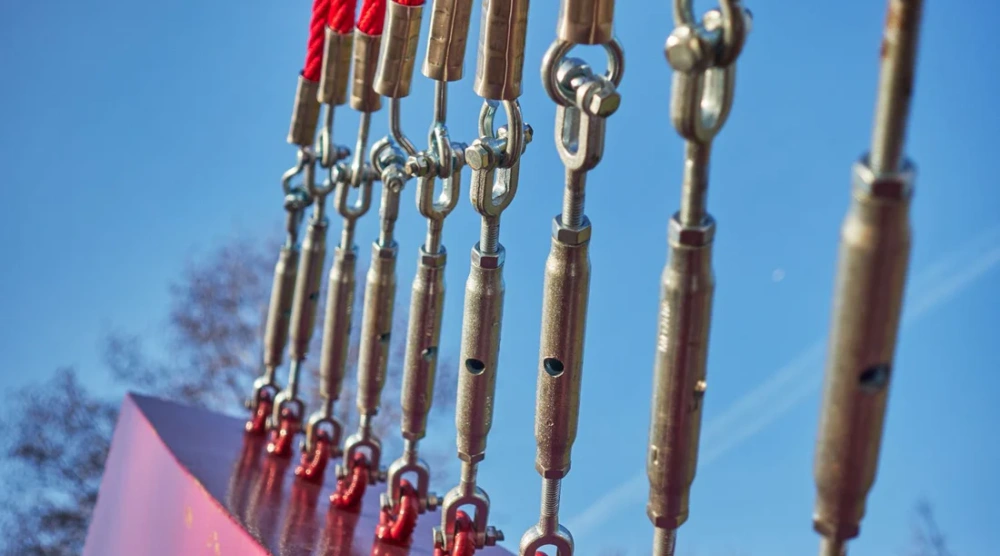
Rigging Applications
You see turnbuckles in many rigging applications. These devices help you adjust tension in cables, wires, and ropes. You use them to stabilize structures with guy wires, keeping towers and bridges secure.
In fencing, turnbuckles prevent sagging and keep wires tight. When you work with rigging, you rely on turnbuckles to maintain safety and stability. Powerful Machinery provides certified solutions for rigging projects in construction, marine, and industrial settings.
- Stabilize towers and bridges with guy wires
- Maintain tension in cables during building projects
- Prevent sagging in fencing systems
- Support temporary and permanent rigging setups
Tip: Always inspect your rigging hardware before use to ensure safety.
Marine and Architectural Uses
Turnbuckles play a vital role in marine and architectural rigging. You use them to tension cables on ships, docks, and waterfront structures. In architectural projects, turnbuckles help you create sleek cable railings and secure shade sails.
Stainless steel turnbuckles from Powerful Machinery resist corrosion, making them ideal for harsh marine environments. You achieve both strength and style in your designs.
Industrial and Construction
In industrial and construction rigging, turnbuckles offer strong connections and quick installation. You can install them on-site within minutes without special tools. The table below highlights key features:
| Feature | Description |
|---|---|
| Quick & Easy Installation | Install on-site within minutes, no special tools needed |
| Strong Connection | Exceeds the rated breaking strength of most ropes, inspected for proper assembly |
| Versatile | Reusable rope termination, available in designs for different rope sizes |
| Proven Quality | Forged and machined materials, conforming to ISO 9001 standards since 1933 |
You trust Powerful Machinery for reliable rigging hardware that meets international standards.
Residential Projects
You find turnbuckles in residential rigging projects as well. Homeowners use them to install shade sails, secure garden trellises, and tension wire balustrades. Turnbuckles make it easy to adjust tension and keep outdoor spaces safe and attractive.
You benefit from simple installation and long-lasting performance. Powerful Machinery offers a range of turnbuckles for residential rigging needs, ensuring quality and safety for every project.
Installing Turnbuckles
Step-by-Step Guide
You need to follow the basic installation steps to ensure your turnbuckle hardware works safely and efficiently. Proper installation helps you achieve the right tension and keeps your rigging equipment secure. Here is how to use a turnbuckle for a secure setup:
- Unscrew both end fittings from the turnbuckle body until you reach the full take-up length. This gives you the maximum range for adjustment.
- Attach each end fitting to its securement point:
- For an eye end, loop it through the anchor or fitting.
- For a hook end, place the hook around the temporary anchor.
- For a jaw end, position the anchor between the clevis ears and insert the bolt or pin.
- Once both ends are attached, rotate the turnbuckle body. This action brings the end fittings closer together and increases the tension in your rigging system.
- When you reach the desired tension, tighten any lock nuts or jam nuts against the body if your turnbuckle hardware includes them.
Tip: Always check that the threads are fully engaged before you apply load. This step prevents accidental slippage and ensures a safe installation.
How to Tighten a Turnbuckle?
Learning how to use a turnbuckle for tensioning is essential for any rigging project. Start by holding one end fitting steady. Use a wrench or your hand to rotate the turnbuckle body.
As you turn, the end fittings move closer together, pulling the cable or wire tight. Stop turning when you reach the correct tension for your application.
- For fine adjustments, turn the body slowly and check the tension often.
- If your turnbuckle has lock nuts, tighten them against the body to secure the position.
- Avoid over-tightening, as this can damage the threads or the rigging equipment.
Note: If you use Powerful Machinery’s jaw swage or toggle turnbuckles, always secure the clevis pin with the split ring or safety clip after tightening.
Safety Tips
Worksite safety should always come first when you install or adjust turnbuckles. Follow these safety tips to protect yourself and your equipment:
- Inspect all turnbuckle hardware for signs of wear, corrosion, or damage before each use.
- Check that the threads are clean and fully engaged with the load.
- Always use turnbuckles within the manufacturer’s specified working load limit.
- Secure the turnbuckle’s position with lock nuts or safety pins to prevent loosening.
- Avoid sudden or shock loads, which can exceed the capacity of your rigging equipment.
- Choose materials that match your environment, such as stainless steel for marine settings.
⚠️ Always wear gloves and eye protection when working with rigging equipment to reduce the risk of injury.
Preventing Loosening
Turnbuckles can loosen over time, especially in environments with vibration or movement. You can prevent loosening by using several proven methods:
- Use lock wire to secure the end fittings and stop them from turning.
- Install jam nuts on both ends of the turnbuckle to hold the fittings in place.
- Insert a hairpin clip into a drilled hole in the turnbuckle screw for extra security.
These steps help you maintain tension and keep your rigging system safe during operation.
Tip: Regularly inspect your turnbuckle hardware and locking mechanisms, especially in high-vibration areas or critical rigging applications.
By following these guidelines, you ensure your installation remains secure and your rigging equipment performs reliably. Knowing how to use a turnbuckle correctly protects both your project and your team.
Turnbuckle Inspection and Maintenance
Inspection Criteria
Inspecting a turnbuckle is essential for safety and reliable performance. You should follow a clear checklist to catch problems early and prevent failures. Here are important criteria to guide your inspection:
- Assess the load capacity and confirm it matches your application.
- Select the correct size and thread diameter for the expected load.
- Check for wear, corrosion, or physical damage during routine inspection.
- Follow manufacturer guidelines for installation and use.
- Verify that threads engage securely at both ends.
- Maintain proper alignment to avoid side loading.
- Apply loads gradually to prevent shock or jerky movements.
- Use locking devices in dynamic or vibrating environments.
- Choose materials suitable for your operating environment.
- Schedule regular inspections and maintenance.
- Keep detailed records of all procedures and findings.
- Ensure personnel receive proper training and certification.
- Prepare emergency response plans for potential failures.
- Monitor loads continuously with appropriate systems.
- Consult experts for complex rigging applications.
- Replace worn components promptly to maintain safety.
Tip: You improve safety and extend service life by inspecting turnbuckles before each use.
Maintenance Tips
You can extend the life of your turnbuckles with simple maintenance practices. Regular care helps prevent corrosion and mechanical failure, especially outdoors.
- Clean turnbuckles often to remove dirt and corrosive substances.
- Lubricate threads and moving parts to reduce friction and prevent rust.
- Apply anti-rust sprays or grease in harsh environments.
- Test the load capacity after noticing wear or damage.
- Replace any turnbuckle that shows significant corrosion or wear.
- Keep records of all inspections and maintenance activities.
Note: Consistent maintenance reduces the risk of unexpected breakdowns and keeps your rigging system reliable.
Standards and Certification
You should always choose turnbuckles that meet strict industry standards. Powerful Machinery’s products comply with international certifications such as ISO 9001, ASME, and OSHA. These standards guarantee safety and quality in critical rigging applications.
Inspections follow the latest ASME guidelines, including B30.9 for slings, B30.10 for hooks, and B30.26 for rigging hardware. DNV certification and LEEA guidelines also ensure that your equipment meets global benchmarks. By selecting certified products, you protect your team and your project.
Selecting Turnbuckles for Rigging
Matching Components
You need to match each component in your rigging system for safe and reliable performance. Start by checking the compatibility between your turnbuckle and the wire rope or cable. Select the correct thread size and end fitting for your application.
For example, jaw ends work well with anchor points, while eye ends fit loops or rings. Make sure the material of your turnbuckle matches the environment. Stainless steel resists corrosion in marine settings. Galvanized steel suits outdoor construction.
Powerful Machinery provides detailed specifications for every product, so you can choose the right fit for your project.
Tip: Always confirm the working load limit of each component before installation. This step helps prevent overload and keeps your rigging secure.
Supplier Selection
Choosing the right supplier for custom rigging solutions makes a big difference in your project’s success. You should look for these key factors:
- Design precision. Suppliers use CAD technology and finite element analysis to create accurate models and predict performance.
- Material selection. A good supplier offers a range of materials for different environments.
- Manufacturing excellence. High-quality standards and certifications like ISO 9001 show commitment to safety.
- Testing and quality control. Rigorous testing ensures reliability and reduces the risk of failure.
- Customer service. Effective communication and personalized support help you meet your project requirements.
Powerful Machinery stands out by combining advanced engineering, strict quality control, and responsive customer support. You get certified turnbuckles that meet international standards and fit your specific needs.
Custom Solutions
Every rigging project has unique challenges. You may need custom turnbuckle sizes, materials, or finishes. Powerful Machinery works directly with you to design and manufacture custom-engineered solutions.
Their team uses advanced modeling and testing to ensure each product meets your specifications. You receive support from the initial consultation to the final delivery. This approach helps you solve complex rigging problems and achieve reliable results.
| Custom Solution Feature | Benefit to You |
|---|---|
| Tailored Design | Fits your exact requirements |
| Certified Materials | Ensures safety and durability |
| Expert Support | Guides you through each step |
You can trust Powerful Machinery to deliver turnbuckles that perform in the toughest environments.
Conclusion
You now understand how a turnbuckle works and why it matters in rigging. When you choose certified turnbuckles from Powerful Machinery, you get reliable performance and safety.
Regular inspection and proper maintenance help you avoid problems and keep your rigging secure. If you need expert advice or custom solutions, reach out to Powerful Machinery for support.
FAQ
How do you choose the right turnbuckle fitting for your project?
You should match the fitting to your cable type and load requirements. Jaw fittings work well for anchor points. Eye fittings suit loops or rings. Hook fittings allow quick connections. Always check the fitting material for your environment.
Can you replace a damaged fitting on a turnbuckle?
Yes, you can replace a damaged fitting. Make sure you select the correct fitting size and type for your turnbuckle. Always follow the manufacturer’s instructions. Inspect the new fitting before installation to ensure safety.
What is the difference between jaw, eye, and hook fittings?
Jaw fittings provide secure connections for heavy loads. Eye fittings create permanent loops for wire ropes. Hook fittings allow fast attachment and removal. Each fitting serves a unique purpose in rigging systems.
How do you prevent a fitting from loosening during use?
You can use lock nuts, safety pins, or wire to secure the fitting. Regularly inspect each fitting for signs of movement. Tighten the fitting as needed. These steps help maintain tension and keep your rigging safe.
Are stainless steel fittings better for marine environments?
Stainless steel fittings resist corrosion in marine settings. You should choose stainless steel for saltwater exposure. This fitting type lasts longer and keeps your rigging secure. Always inspect the fitting for signs of rust or wear.

